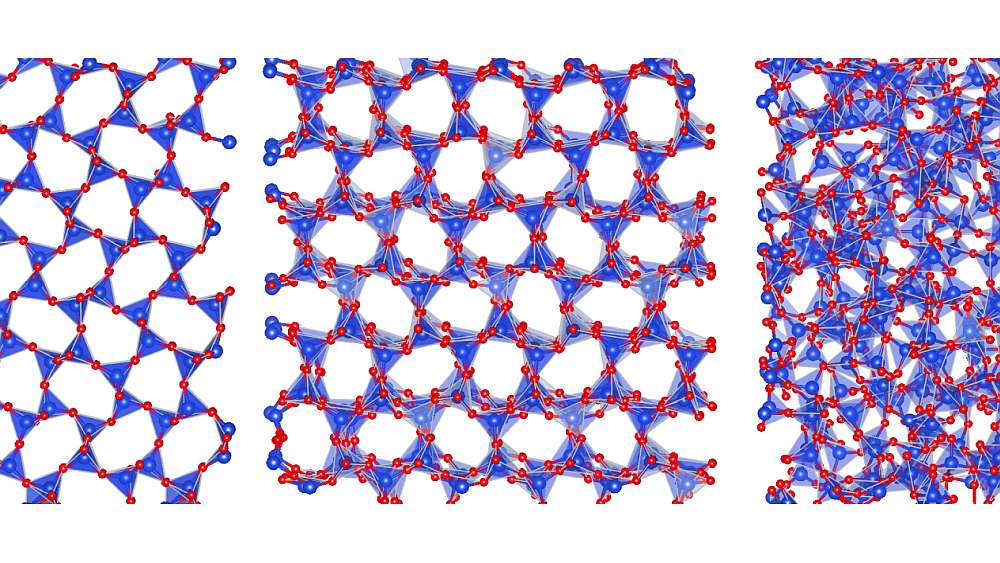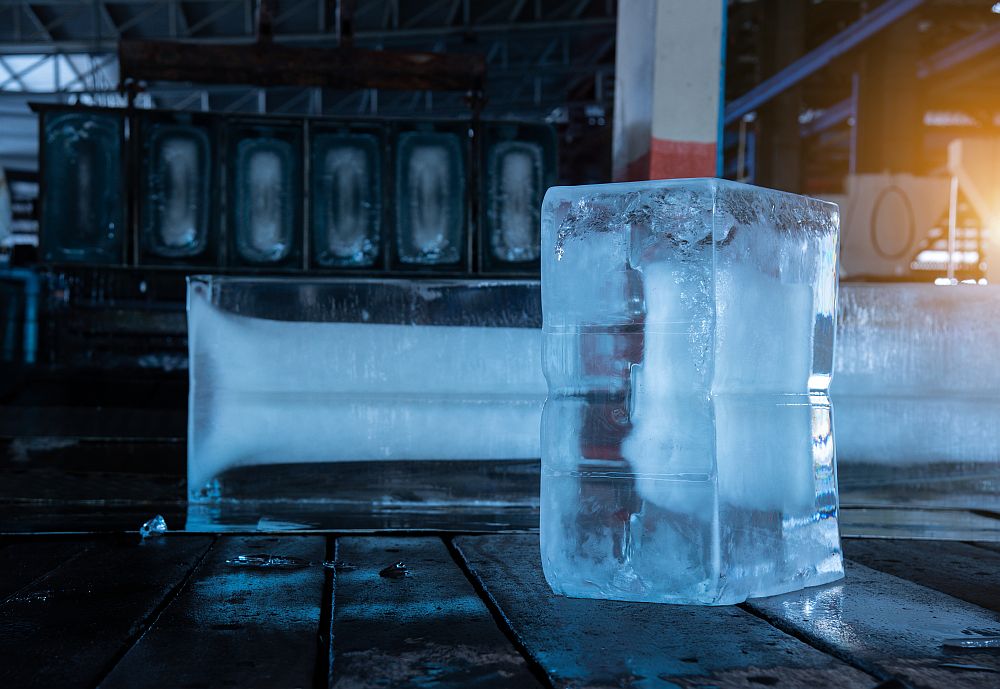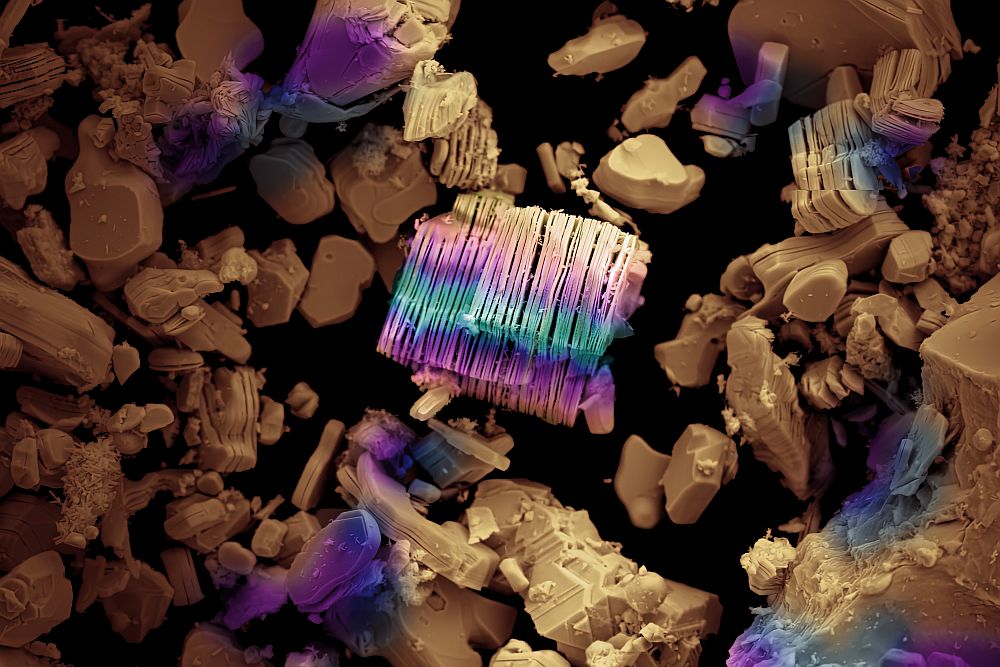
[Image above] Illustrations of crystalline meteoritic tridymite (left), tridymite with crystalline bond order and amorphous bond geometry (center), and completely amorphous silica glass (right). Red represents oxygen, blue represents silicon, and common SiO4 tetrahedral arrangements are highlighted in shaded blue. Credit: Simoncelli Lab, Columbia University
Ceramic and glass materials share many things in common, including being extremely hard, chemically inert, and good electrical insulators. But they also demonstrate unique behaviors based on their differing atomic structures.
Consider, for example, the thermal conductivity of ceramics and glass. As these materials are heated, the thermal conductivity decreases and increases, respectively, due to how it affects atomic vibrations differently in the ordered and disordered structures.
But as we demonstrated earlier this month on CTT, the division between an ordered and disordered material is not always clear-cut. In that case, the coexistence and compensation of different heat-transport mechanisms may cause the multiphase material to demonstrate unique thermal behavior.
In July 2025, a paper published in Proceedings of the National Academy of Sciences described the distinctive thermal properties of one special crystal–glass hybrid material. The results of this study, which could lead to improved refractory design, were made possible thanks to a relatively new thermal transport formula developed six years ago by the study’s authors.
Developing the Wigner transport equation
Back in 2019, Michele Simoncelli was a Ph.D. student in the group of Nicola Marzari, professor and director of NCCR MARVEL at Swiss Federal Institute of Technology Lausanne–EPFL. They collaborated with Francesco Mauri, professor of theoretical solid-state physics at the University of Rome Sapienza, to derive a general formula of thermal transport that describes the phenomenon equally well in both ordered and disordered materials, as well as everything in between.
This formula, which was reported on CTT in June 2019, successfully unified the classical thermal transport formulas: the Boltzmann transport equation (BTE) for simple crystals and the Allen–Feldman (AF) formulation for harmonic glasses. The key to developing their general formula was accounting for a fundamental component of heat propagation—quantum tunneling.
“[Phonon wave packets] are not only allowed to propagate particle-like in space but also to tunnel, wave-like, from one branch to another,” Simoncelli and his colleagues explain in their 2019 paper. While such tunneling contributions are negligible in perfect crystals, the tunnels become more relevant as system disorder increases.
To account for quantum tunneling, they derived their general transport equation from the Wigner phase space formulation of quantum mechanics. They then showed how this general equation can be reduced to both the BTE and AF formulations.
In the six years since that publication, Simoncelli graduated and became a research fellow at the University of Cambridge in England. In January 2025, he joined Columbia University in New York as an assistant professor of applied physics and applied mathematics.
Simoncelli continued to work with Marzari and Mauri on thermal transport problems throughout his career transitions. They along with several other groups successfully used the newly developed Wigner transport equation (WTE) to rationalize the milder-than-expected conductivity decay observed in some complex anharmonic crystals, such as here, here, and here.
Notably, in all these studies, the thermal transport behavior was investigated in the classical regime, i.e., above the Debye temperature. This temperature represents the point at which the thermal energy is large enough to excite all possible phonon modes in the crystal, and so the particle-like behavior of the phonons is dominant. In contrast, below the Debye temperature (quantum regime), both the wave-like and particle-like behavior of the phonons must be considered.
In the new paper, Simoncelli, Marzari, and Mauri used WTE to investigate the thermal transport behavior of a unique crystal–glass hybrid material across both the quantum and classical regimes.
Temperature-invariant thermal properties of crystal–glass hybrids
Thermal conductivity is usually a temperature-dependent physical property, either decreasing or increasing as a material is heated. In some cases, though, materials can demonstrate temperature-invariant thermal conductivity, meaning the conductivity remains constant across a range of temperatures.
In previous studies on alloys and glasses, researchers demonstrated temperature-invariant conductivities within the classical regime. But in the new study, Simoncelli, Marzari, and Mauri used WTE to predict that a specific phase of tridymite, a form of silicon dioxide described in the 1960s as typical of meteorites, may exhibit temperature-invariant conductivity in both the quantum and classical regimes.
As explained in a Columbia University press release, Simoncelli and his colleagues needed a way to experimentally test this theory about tridymite’s thermal properties. So, they teamed up with Sorbonne University researchers Etienne Balan, Daniele Fournier, and Massimiliano Marangolo in France, who obtained permission from the National Museum of Natural History in Paris to perform experiments on a sample of tridymite carved from the meteorite that landed in Steinbach, Germany, in 1724.
Thermoreflectance analysis of the meteorite sample confirmed their predictions: the tridymite’s thermal conductivity remained essentially constant over the experimentally accessible temperature range of 80 K to 380 K.
Though the thermal properties of meteorites may seem far removed from industrial applications, Simoncelli and his colleagues point out that tridymite has also been found on the surface of refractory silica bricks.
As a result, materials derived from tridymite “may be exploited to increase the efficiency of steel furnaces, since recent reports discussed how a [thermal] conductivity increase in refractory silica bricks may lead to energy saving and consequently reduction of CO2 emissions,” Simoncelli and his colleagues write.
The paper, published in Proceedings of the National Academy of Sciences, is “Temperature-invariant crystal–glass heat conduction: From meteorites to refractories” (DOI: 10.1073/pnas.2422763122).
Author
Lisa McDonald
CTT Categories
- Basic Science
- Modeling & Simulation
- Refractories
- Thermal management


